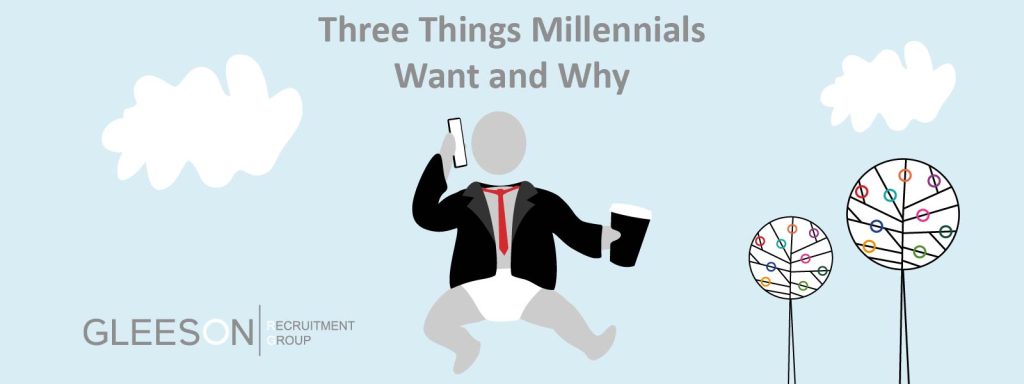What Millennials Want At Work, And Why
RECRUITMENT • Oct 12, 2018

Here’s the thing about what millennials want: they want quite a lot of things.
Call them entitled, call them naïve, call them ‘Generation Me’. At the end of the day, you don’t have to like them. But seeing as they’ll make up half the working population by 2020, you will have to hire them. For the purposes of attracting and retaining the members of this much-discussed generation, it would help if employers understood where they were coming from.
I’ll do my best to explain.
- Work-Life Balance.
We’ve all been beaten over the head with this phrase a bit, I won’t deny that. If it was a snack, it would be tasteless by now. But the thing about things that are insanely ubiquitous is that they tend to be insanely popular. Which is what the concept of work-life balance is to millennials. Insanely popular.
This really is one to keep in mind if you’re an employer, because unlike most trends, the idea of having a decent balance between one’s working life and one’s personal life probably won’t drift out of fashion any time soon. Flares and frosted tips will come and go, but I’m afraid this concept is here to stay. The reason for that being is that it’s, well, quite reasonable. When you think about it, who wouldn’t want a balance between work and leisure time?
70% of millennials will select a job on the basis that it allows flexibility – more than any other generation. But then, that’s not surprising, seeing as their mentality is ‘work smarter, not harder’. This might mean some of them coming in for a handful of days a week and working from home the rest of the time. It might mean them making up the hours they’ve missed without fearing a disciplinary if they need to pick their kids up from school. It might mean that some work through the night, and others start at dawn.
It sounds chaotic in theory, but research indicates that this fresh take on our approach to working hours can give businesses a big productivity boost. A study by HSBC reported that 9 out of 10 employees consider flexible working to be their biggest motivator; trumping financial incentives. So, before you shell out a guilty Christmas bonus because you’ve insisted that half the staff miss seeing their children in the school nativity play, perhaps pause and consider who you’re really hurting by offering money over flexibility. Millennials are notoriously shameless when it comes to job-hopping – and they won’t stick around for long with an employer who expects staff to sacrifice everything for their job.
- Engagement
Have you ever seen a character in a film who can’t stand their job?
You know what I’m talking about; that guy with a slack jaw and glazed eyes, doing the same repetitive tasks day after day in a cubicle that, for some, inexplicable reason, is always a sludgy pea-green.
Have you got the image in your head?
Ok, well that there is pretty much the definition of disengagement. It’s not a fun notion for most people, but for millennials, that’s a worst nightmare of apocalyptic proportions; right up there with watching climate change melt their iPhones and destroy their beloved avocados. Remember that they’ve spent a greater percentage of their lives being bombarded with more information from the media than any generation before them, and most of them have had to think about where they fit into a vast, global network from a young age. As such, they’re quite keen to know where their place is in the grand scheme of things.
Luckily, keeping up employee engagement levels is largely a matter of exercising a combination of empathy and common sense. I suggest that you:
- Give praise for a job well done.
- Clarify what needs to be done for them to progress quickly in their career.
- Ensure they know how their work is helping others and/or the business.
- Don’t make anyone work in a cubicle.
- A Cool Office
Yes, I suppose you could sniff and insist that your office is ‘perfectly functional as it is’ but guess what – so are prison cells. Unlike inmates, millennials looking for work are able to be quite selective about the environment they’ll be spending a good deal of their time in. Research has found that as much as a fifth of millennials in the UK have decided against accepting a job due to an uninspiring office design. Chew that one over.
Now, let’s talk about what I mean by a ‘cool office’. By cool, I don’t mean ‘lavish’ or ‘extreme’. Huge companies (see: Google, Nokia, Facebook) might have the kind of budget where swarms of architects and interior designers can be summoned to build kaleidoscopic, intricately decorated empires of Disney-like proportions, but that’s a fairly extreme take on a cool office (a bit like all of us agreeing that Buckingham Palace is a ‘nice house’). Obviously, those offices definitely are cool, and most millennial staff probably would quite enjoy hurtling into meetings on a zip wire before going to play with penguins in the chill out zone, or whatever it is they do in these places – but there’s an aspirational wedge of middle ground for the rest of us to perch on. Come sit.
When it comes to creating an appealing aesthetic, think less Charlie and the Chocolate Factory, more the IKEA home office range. You don’t have to squander thousands on an overhaul of the entire building if the space is a little basic. Create a few breakout areas away from the desks, avoid a joyless colour scheme, throw in a smattering of plants, and you’re basically there. If you’ve got a hefty budget which you want to devote to splashing out on a cutting-edge revamp, feel free to up the ante.
Credit: Clare Toner




